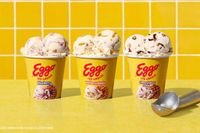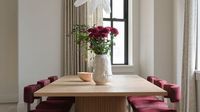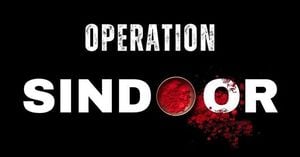In 2025, the world of interior design is witnessing an unexpected revival of 1990s trends that many thought were long forgotten. From chrome finishes to rounded fireplaces, these design elements are being reimagined in fresh, exciting ways that fit the vibrant and carefree spirit of today. Designers, many of whom grew up in that iconic decade, are now leading the charge to incorporate these elements, showcasing not just nostalgia but also an evolution of style.
One standout trend making a comeback is chrome finishes. Once seen only in minimalist spaces, chrome is now finding a place in more eclectic environments. As LA-based interior designer Jake Arnold notes, 'I’ve always used brass and warm tones a lot, but I choose chrome for things like serveware because it juxtaposes so well with other natural elements like wood and wicker.' In 2025, chrome is not constrained to traditional minimalism; instead, it interacts dynamically with softer design aspects, breathing new life into dining experiences.
Another significant 90s influence is the return of rounded fireplaces. These once-ubiquitous features, referred to by Santa Fe-based designer Heather French, were characterized by their bulbous shapes that contrasted sharply with the angular furniture designs of the time. French highlights the appeal of rounded designs, stating, 'A lot of the architecture around Santa Fe is from the 1990s, and a lot of it is bulbous and rounded.' In modern constructions, these fireplaces serve as inviting focal points, blending beautifully with equally curved modern sofas. Their flexibility in layout suits contemporary living, rendering them a popular choice in new builds.
Monochrome, or black-and-white palettes, are also weaving their way back into designer schemes. As explained by New York-based designer Sarah Tract, 'You need to lean into monochrome elements that aren't so expected.' Layering textures and materials within a monochrome framework allows for bold, graphic statements without overwhelming the senses. Standout pieces, like a pristine black chair against a white backdrop, help to ground a room and provide visual interest.
Gray walls, which became a neutral staple in the 1990s, are regaining traction again in 2025. They offer versatility and elegance while complementing trendy shades such as taupe and oxblood. 'The curtains led the choice of gray for the walls in this dining room,' says Tract, sharing insights on how modern designers select hues that complete a room's aesthetic rather than merely filling a space.
Lastly, the trend of unfinished edges reflects a deeper appreciation for industrial materials, a concept that gained momentum in the 1990s. Seen in kitchens like those designed by Jo Berryman, elements like raw-edged backsplashes signify a blending of luxury with rugged charm. Berryman describes her vision: 'We wanted the kitchen to feel so unlike a typical country kitchen. Elemental, not rustic.' Incorporating rich earthy tones like copper and terracotta, these modern kitchens inspire a visceral connection to nature.
As these 90s design trends make their way back into contemporary interior spaces, it's clear that their revival is not merely a throwback. Rather, they embody a resilient spirit that showcases the evolution of design aesthetics. The interplay of nostalgia and modern sensibilities creates visually stunning spaces that celebrate the past while looking boldly towards the future.
With an increasing number of designers turning to these trends in their work, the 1990s not only remain relevant but serve as a cornerstone for fresh, innovative designs. These elements are markers of a continuous dialogue in the design world, revealing that great styles are cyclical, adaptable, and deeply embedded in the ways we choose to live.





